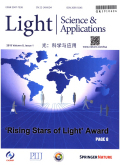- 钛学术文献服务平台 \
- 学术期刊 \
- 工业技术期刊 \
- 电工技术期刊 \
- 光:科学与应用(英文版)期刊 \
Mechanism of the trivalent lanthanides' persistent luminescence in wide bandgap materials
Mechanism of the trivalent lanthanides' persistent luminescence in wide bandgap materials
基本信息来源于合作网站,原文需代理用户跳转至来源网站获取
摘要:
The trivalent lanthanides have been broadly utilized as emitting centers in persistent luminescence (PersL) materials due to their wide emitting spectral range, which thus attract considerable attention over decades. However, the origin of the trivalent lanthanides' PersL is still an open question, hindering the development of excellent PersL phosphors and their broad applications. Here, the PersL of 12 kinds of the trivalent lanthanides with the exception of La3+, Lu3+, and Pm3+is reported, and a mechanism of the PersL of the trivalent lanthanides in wide bandgap hosts is proposed. According to the mechanism, the excitons in wide bandgap materials transfer their recombination energy to the trivalent lanthanides that bind the excitons, followed by the generation of PersL. During the PersL process, the trivalent lanthanides as isoelectronic traps bind excitons, and the binding ability is not only related to the inherent arrangement of the 4f electrons of the trivalent lanthanides, but also to the extrinsic ligand field including anion coordination and cation substitution. Our work is believed to be a guidance for designing high-performance PersL phosphors.

推荐文章
基于World Wide Web的课件设计方法
课件
WWW
教学
多媒体
Mechanism of accelerated dissolution of mineral crystals by cavitation erosion
Cavitation erosion
Mineral dissolution
Plastic deformation
Stepwave
Gibbs free energy
An EXAFS investigation of the mechanism of competitive sorption between Co(Ⅱ) and Ni(Ⅱ) at γ-alumi
Co(Ⅱ)
Ni(Ⅱ)
γ-Al2O3
Competitive sorption
EXAFS
内容分析
关键词云
关键词热度
相关文献总数
(/次)
(/年)
文献信息
| 篇名 | Mechanism of the trivalent lanthanides' persistent luminescence in wide bandgap materials | ||
| 来源期刊 | 光:科学与应用(英文版) | 学科 | |
| 关键词 | |||
| 年,卷(期) | 2022,(3) | 所属期刊栏目 | Articles |
| 研究方向 | 页码范围 | 375-382 | |
| 页数 | 8页 | 分类号 | |
| 字数 | 语种 | 英文 | |
| DOI | |||
五维指标
引文网络
引文网络
二级参考文献 (0)
共引文献 (0)
参考文献 (0)
节点文献
引证文献 (0)
同被引文献 (0)
二级引证文献 (0)
2022(0)
- 参考文献(0)
- 二级参考文献(0)
- 引证文献(0)
- 二级引证文献(0)
引文网络交叉学科
相关学者/机构
期刊影响力
光:科学与应用(英文版)
主办单位:
中国科学院长春光学精密机械与物理研究所
出版周期:
双月刊
ISSN:
2095-5545
CN:
22-1404/O4
开本:
出版地:
吉林省长春市东南湖大路3888号
邮发代号:
创刊时间:
语种:
eng
出版文献量(篇)
762
总下载数(次)
0
总被引数(次)
112
期刊文献
相关文献
推荐文献

 免费查重
免费查重










